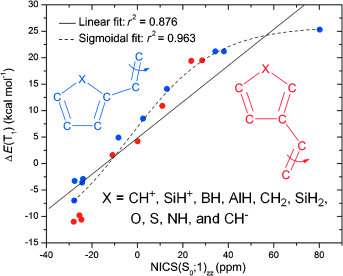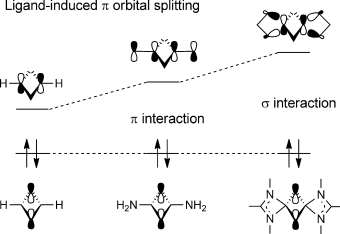Nature Chemistry





A density functional theory study on olefins with five-membered monocyclic 4n and 4n+2 π-electron substituents (C4H3X; X=CH+, SiH+, BH, AlH, CH2, SiH2, O, S, NH, and CH−) was performed to assess the connection between the degree of substituent (anti)aromaticity and the profile of the lowest triplet-state (T1) potential-energy surface (PES) for twisting about olefinic CC bonds. It exploited both Hückel’s rule on aromaticity in the closed-shell singlet ground state (S0) and Baird’s rule on aromaticity in the lowest ππ* excited triplet state.

The many manifestations of aromaticity have long fascinated both experimentalists and theoreticians. Due to their degenerate half-filled MOs, triplet [n]annulenes with 4n π-electrons are also aromatic, but the degree of their stabilization has been difficult to quantify. The isomerization stabilization energy (ISE) method has been applied to evaluate the triplet aromaticity. The reliability of this approach is indicated by the strong correlation of the ISE results with NICS(1)zz, a magnetic indicator of triplet state aromaticity.

A one-pot synthesis of 3,4,5- and 1,3,5-pyrazoles from tertiary propargylic alcohols and para-tolylsulfonohydrazide has been accomplished. The pyrazoles are formed through a four-step cascade sequence, including FeCl3-catalyzed propargylic substitution, aza-Meyer–Schuster rearrangement, base-mediated 6π electrocyclization, and thermal [1,5] sigmatropic shift. In this reaction, the 3,4,5- and 1,3,5-pyrazoles are produced selectively according to different substituents in the starting alcohols.

Anti-aromatic compounds, as well as small cyclic alkynes or carbynes, are particularly challenging synthetic goals. The combination of their destabilizing features hinders attempts to prepare molecules such as pentalyne, an 8π-electron anti-aromatic bicycle with extremely high ring strain. Here we describe the facile synthesis of osmapentalyne derivatives that are thermally viable, despite containing the smallest angles observed so far at a carbyne carbon.

We report herein the first example of the conversion of metallabenzyne II and isometallabenzene III. The osmium hydride vinylidene complex 1 reacts with HCCCH(OEt)2 to give osmabenzyne 3 via isoosmabenzene 2. Compound 3 exhibits high thermal stability in air. Nonetheless, nucleophilic attack at 3 provides isoosmabenzenes 4 a and 4 b, or opens the ring to produce 5 a and 5 b.

The electronic and structural features of (oxo)manganese(V) corroles and their catalyzed oxygen atom transfers to thioanisole in different spin states have been investigated by the B3LYP functional calculations. Calculations show that these corrole-based oxidants and their complexes with thioanisole generally have the singlet ground state, and their triplet forms are also accessible in consideration of the spin–orbit coupling interaction.

Density functional theory calculations (B3LYP) have been carried out to investigate the 4π-electron systems of 2,4-disila-1,3-diphosphacyclobutadiene (compound 1) and the tetrasilacyclobutadiene dication (compound 2). The calculated nucleus-independent chemical shift (NICS) values for these two compounds are negative, which indicates that the core rings of compounds 1 and 2 have a certain amount of aromaticity.

Cationic metal ion-coordinated N-diisopropyloxyphosphoryl dipeptides (DIPP-dipeptides) were analyzed by electrospray ionization multistage tandem mass spectrometry (ESI-MS n ). Two novel rearrangement reactions with hydroxyl oxygen or carbonyl oxygen migrations were observed in ESI-MS/MS of the metallic adducts of DIPP-dipeptides, but not for the corresponding protonated DIPP-dipeptides.

The fragmentation pathways of both protonated and sodiated pentacoordinate spirobicyclic aminoacylphosphoranes (P-AAs) have been studied by electrospray ionization multi-stage mass spectrometry (ESI-MSn) in positive mode. The possible pathways and their mechanisms are elucidated through the combination of ESI-MS/MS, isotope (15 N and 2H) labeling and high-resolution Fourier transform ion cyclotron resonance (FTICR)-MS/MS. The relative Gibbs free energies (ΔG) of the product ions and possible fragmentation pathways are estimated at the B3LYP/6-31 G(d) level of theory.

Two-dimensional hexagonal composite materials (BN)n(C2)m (n, m = 1, 2, ...), which all are isoelectronic with graphene and hexagonal boron nitride (h-BN), have been studied by density functional theory (DFT) with a focus on the relative energies of different material isomers and their band gaps. The well-established chemical concepts of conjugation and aromaticity were exploited to deduce a rationale for identifying the thermodynamically most stable isomer of the specific composites studied.
Copyright © 2025,
Theme Originally Created by Devsaran
